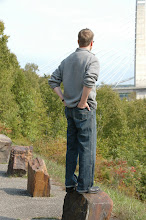Ok, so it is not my term but I do have
vampires at my electrical sockets. Don't know what an electrical outlet vampire is? This terms refers to electronic devices (tv, computer printers, my shredder) that continue to use electricity even when turned off and not being used (i.e. the appliance sits there in stand-by mode still drawing electricity). In any given moment the usage is not lot. But these devices tend to be plugged in at all times and we are bringing more and more of these consumer electronics into our lives. What to do? Well, until electronics companies move away from bad design (design for me is, in part, about stripping away waste and inefficiencies, as well as acheiving a certain level of aesthetics and use-value) and start creating devices that don't drink up electricty at all times, you have to intervene yourself.
A quick inventory of my electrical sockets:
- Bathroom. Nothing plugged in unless I am using it.
- Bedroom. One outlet empty--I used it to recharge a cellphone, run a humidifior in the winter, and the like. Another plug holds a clock and my A/C. And the last plug has another clock and a lamp. Two clocks in one room? Guess I never know the time.
- Kitchen. One one outlet here and nothing is in it unless I'm using it (coffee maker or grinder, usually).
- Living Room. Two outlets. One has a lamp plugged into it along with a power strips that my tv, cable box, DVD player, and some small speakers plug into. I flip the power strip switch when I'm not using any of the above to avoid the unnecessary power usage of the tv. The other outlet in the room also has a lamp and a power strip. This power strip has the router and modem plugged into.
- Study. One outlet here with a power strip. In it are my printer, shredder, and other odd computer equipment. I plant to rearrange so I can shut this one off when I'm not using any of the equipment and avoid the unnecessary energy usage.
I did once experiment with a small solar charger that is suppoed to be able to charge batteries, cell phones and USB devices. But it doesn't work very well. I think part of it is that I don't really have a good place for it to get long exposure to direct sunlight. The drawback of living in an apartment in a row of houses.

